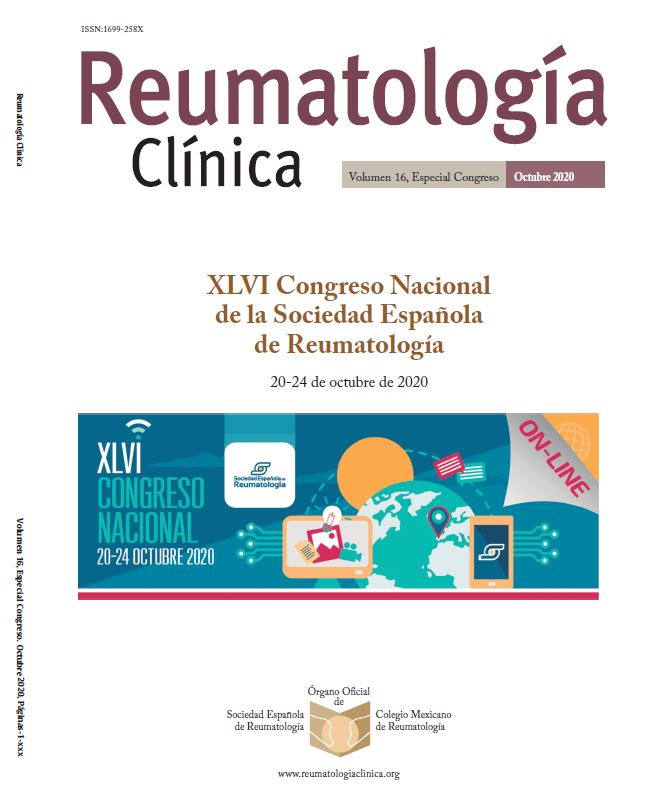P066 - Clinical response to biologic DMARDs in axial spondyloarthritis and axial psoriatic arthritis. Different diseases, same outcomes?
Hospital La Paz. Idipaz. Madrid.
Introduction: Patients with psoriatic arthritis may present predominant axial involvement. Currently, it is unclear whether these patients should be considered as axial spondyloarthritis (axSpA) with psoriasis or psoriatic arthritis with axial involvement -also known as axial PsA (axPsA)-. Data comparing medium-term treatment response to biological drugs in axSpA and axPsA would add relevant information to answer this question.
Objectives: To compare the clinical response and predictor factors after one year of biological therapy in patients with axSpA and axPsA.
Methods: One-year follow-up data from all patients (pts) with axSpA or axPsA (defined by the treating rheumatologist) included in a prospective cohort of pts receiving biological therapy between 2002 and 2019 were analysed. Demographic information, laboratory tests, concomitant treatments and disease status were collected at baseline. Clinical disease activity was measured by PhGA and ASDAS criteria at baseline, 6 and 12 months. According to ASDAS, disease activity was defined as: inactive disease (ID) (ASDAS < 1.3), low disease activity (LDA) (ASDAS 1.3-2.1), high disease activity (HDA) (ASDAS 2.1-3.5) and very high disease activity (VHDA) (ASDAS > 3.5). Clinical important improvement and major improvement were defined by ASDAS (delta-ASDAS ≥ 1.1 and ≥ 2.0, respectively). According to PhGA, disease activity was assorted by consensus of 3 expert rheumatologists in: ID with PhGA < 5, LDA with PhGA 5-30, HDA with PhGA > 30-60 and VHDA with PhGA > 60. Clinical improvement by PhGA was defined as an improvement of 30% compared to baseline at the studied points). In the statistical analysis, the frequency of pts achieving each clinical activity status and clinical improvement at 6m and 12m were compared using Fisher test, separately for axSpA and axPsA. Baseline predictor factors for achieving clinical response and clinical improvement were identified using univariable and multivariable binary regression.
Results: Out of 352 included pts, 287 (81.5%) had axSpA and 65 (18.5%) axPsA. Sixty percent were males, 158 (45%) smokers, with mean (SD) baseline disease activity of ASDAS: 3.3 (0.9) and PhGA: 39.1 (21.5). Biological therapies initiated included antiTNF in 93.8% and secukinumab in 6.2%. In comparison to axPsA, pts with axSpA were more HLA B27 positive (p < 0.001) and had better PhGA at baseline (p = 0.02). They also had more uveitis (p = 0.03) and were more radiographically affected (p < 0.001). Response rates at 6m and 12m in both diseases according to ASDAS are shown in Table 1. Both diseases presented a similar clinical response, and no statistically significant differences were observed for any disease activity interval between them for ASDAS or PhGA. Clinical improvement is shown in Table 2. There were no differences between both diseases on this, regardless the improvement measurement. In the group of axSpA, the univariate analysis observed that LDA (by ASDAS) at 12m was associated with male gender (OR = 2.8, p = 0.001) and HLAB27 positive (OR = 2.3, p = 0.01). In the multivariate analysis, both variables remained significantly associated with LDA (male gender: OR = 2.7, p < 0.01; and HLAB27 positivity OR = 2.6, p < 0.01). In the group of axPsA, the univariate analysis showed a tendency that male pts achieved LDA more frequently at 6m (OR = 3.0, p = 0.05) and at 12m (OR = 2.75, p = 0.09). In the multivariable analyses, none of the factors was significantly associated neither with clinical improvement nor with LDA in pts with axPsA.
|
Table 1. Response rates at 6m and 12m in axSpA and axPsA by ASDAS |
||||||
|
6m |
12m |
|||||
|
axSpA (n = 227) |
axPsA (n = 62) |
p value |
axSpA (n = 191) |
axPsA (n = 50) |
p value |
|
|
ID, n (%) |
63 (27.8) |
19 (30.6) |
0.65 |
56 (29.3) |
16 (32) |
0.73 |
|
LDA, n (%) |
57 (25.1) |
17 (26.2) |
0.74 |
55 (28.8) |
14 (28) |
0.91 |
|
HDA, n (%) |
85 (37.4) |
22 (33.8) |
0.88 |
65 (34) |
16 (32) |
0.86 |
|
VHDA, n (%) |
22 (9.7) |
4 (6.2) |
0.62 |
15 (7.9) |
4 (8) |
0.97 |
|
Table 2. Clinical improvement in axSpa and AxPsA by ASDAS |
||||||
|
6m |
12 m |
|||||
|
axSpA (n = 227) |
axPsA (n = 62) |
p value |
axSpA (n = 191) |
axPsA (n = 50) |
p value |
|
|
Clinical improvement, n (%) |
118 (51.9) |
29 (48.3) |
0.6 |
109 (57.1) |
25 (50) |
0.4 |
|
Major improvement, n (%) |
64 (28.1) |
16 (26.7) |
0.8 |
25 (50) |
109 (57) |
0.4 |
Conclusions: In clinical practice, pts with axSpA and axPsA present a similar clinical response to biological therapy within the first year of treatment. Male pts seem to have better medium-term outcomes in both diseases, and HLA B27 pts respond better in axSpA.







